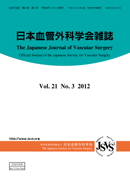Volume 17, Issue 5
Displaying 1-13 of 13 articles from this issue
- |<
- <
- 1
- >
- >|
-
2008 Volume 17 Issue 5 Pages 539-544
Published: August 25, 2008
Released on J-STAGE: September 01, 2008
Download PDF (495K) -
2008 Volume 17 Issue 5 Pages 545-550
Published: August 25, 2008
Released on J-STAGE: September 01, 2008
Download PDF (485K) -
2008 Volume 17 Issue 5 Pages 551-556
Published: August 25, 2008
Released on J-STAGE: September 01, 2008
Download PDF (535K) -
2008 Volume 17 Issue 5 Pages 557-564
Published: August 25, 2008
Released on J-STAGE: September 01, 2008
Download PDF (481K)
-
2008 Volume 17 Issue 5 Pages 565-568
Published: August 25, 2008
Released on J-STAGE: September 01, 2008
Download PDF (367K) -
2008 Volume 17 Issue 5 Pages 569-573
Published: August 25, 2008
Released on J-STAGE: September 01, 2008
Download PDF (439K) -
2008 Volume 17 Issue 5 Pages 575-580
Published: August 25, 2008
Released on J-STAGE: September 01, 2008
Download PDF (483K) -
2008 Volume 17 Issue 5 Pages 581-585
Published: August 25, 2008
Released on J-STAGE: September 01, 2008
Download PDF (490K) -
2008 Volume 17 Issue 5 Pages 587-592
Published: August 25, 2008
Released on J-STAGE: September 01, 2008
Download PDF (554K) -
2008 Volume 17 Issue 5 Pages 593-596
Published: August 25, 2008
Released on J-STAGE: September 01, 2008
Download PDF (327K) -
2008 Volume 17 Issue 5 Pages 597-599
Published: August 25, 2008
Released on J-STAGE: September 01, 2008
Download PDF (84K) -
2008 Volume 17 Issue 5 Pages 601-604
Published: August 25, 2008
Released on J-STAGE: September 01, 2008
Download PDF (371K) -
2008 Volume 17 Issue 5 Pages 605-610
Published: August 25, 2008
Released on J-STAGE: September 01, 2008
Download PDF (563K)
- |<
- <
- 1
- >
- >|
